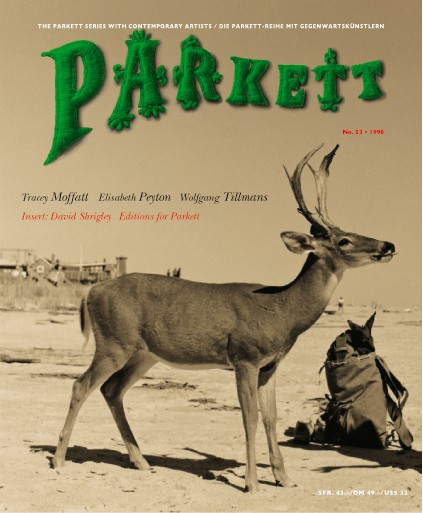
Soft Cover, German, Thread Stitching, 256 Pages, 1998
Parkett No. 53 / 1998
availability unknown, if interested please write an email
Bruce Nauman’s bloodcurdling litany, “Help me, hurt me sociology; feed me, eat me anthropology,” echoed through the halls of art in his video ANTHRO/SOCIO for the first time in 1991.
Nauman’s quest for basics, his objectivization of the human condition has today become the prerequisite for investigations pursued by many young artists lashing out in other directions. It has been a long time since so many people populated the pages of Parkett. Their representation in the work of the collaboration artists in this issue covers the entire spectrum from ecstatic artificiality to existential exposure, from fictional in(ter)vention to vital experience—often in one and the same oeuvre. The deer on the cover may seem misleading but it looks as if the animal has somehow reached a threshold. This timid creature, inhabitant of our forests, which once graced untold musty parlors as an unassuming, upstanding, entirely unexotic embodiment of freedom—what is it doing at the seaside, where an exponent of current youthful urbanity is already disrespectfully encroaching upon its territory? Is this a curious encounter of the peaceful kind inspired by the shared rootlessness of ultimately kindred souls? Another picture by Wolfgang Tillmans shows three youths, their heads stacked as if on a totem pole. They are immersed in a mood of intense concentration, a string trio without instruments, whose performance consists solely of posing and smoking. Through his singular perception and the confidence he inspires, Tillmans challenges people, things and situations to divest moments of their facticity and transform them into ambiguous pictorial products. The power of the photographic image suffuses his subjects to the very core of their being. It is the irreality of mediated life that contributes substantially to the design of reality as a whole. This now familiar insight lends momentum to the confrontation in the newly discovered emotional potential of Elizabeth Peyton’s painting. The collective dream cast of characters in her pictures oscillates between absence and presence. But they are sensual regardless, if only because of their vital imaginative thrust. An act of sweet appropriation quickens the rouge on male skin. One of our authors expressed the wish to touch Peyton’s paintings, while the wayward impalpability of her representations retreats all the more into the background of his perception. What is the relationship of “anthro” to “socio”? Tracey Moffatt’s people act out psychologically charged situations of elemental implications. They appear to be abandoned or detached, and always precariously balanced on the edge of civilization. As if this alone were the place to penetrate the depths of human memory, as if civilization were a grand process that sterilizes what must not be remembered. Another issue has been completed and we look upon David Shrigley’s drawing on the last page of the Insert with a mixture of dismay and satisfaction.
Language: English/German






























